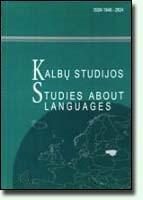Computer Mediated Language and Culture: Salutations and Closings in British and Turkish ‘Call for Papers’ Written in English
Computer Mediated Language and Culture: Salutations and Closings in British and Turkish ‘Call for Papers’ Written in English
Author(s): Çiler HatipoğluSubject(s): Language and Literature Studies
Published by: Kauno Technologijos Universitetas
Keywords: language; culture; technology; Turkish; British; English
Summary/Abstract: Easy access, speed and efficiency have placed e-mailing firmly among the main mediums of communication in the last few decades. Therefore, in the recent years there has been a growing interest in the so called e-mail language (Baron 1998a, b; Hatipoglu 2004) and some researchers have claimed that a distinct medium of interaction with universally valid features (e.g., style and register) is emerging (Gimenez 2000). The present research examines data coming from a collectivist, high uncertainty, high power distance, feminine culture (i.e., Turkish) and an individualistic, low uncertainty, low power distance, masculine culture (i.e., British) and studies the effects of two variables – medium of communication (i.e., electronic messaging) and cultural background – on the format and style of the salutation and closing parts of the e-mailed ‘Call for Papers for international conferences’ (CFPIC) written in English. The specific questions addressed in the study are: (1) Is there a new mode of interaction with mutually agreed upon rules and norms by its users in the cultures scrutinised?, (2) Can the cultural identity of the correspondent override the effects of the medium of interaction on the message, as Hofstede (1991, 2001) claims, and play a primary role in shaping electronic messages? The two sets of e-mail data examined in this research were collected between January 2002 and February 2006 in Britain and Turkey, and the analysis, on which discussions are based, includes comparison and contrast of the organisational and semantic features of the salutations and closing parts of the collected electronic messages. The findings of the study reveal that the relationship between the medium of interaction, the cultural background of interlocutors and the quality of the electronic messages is complex and dynamic. The results also show that there are not still firmly agreed conventions governing electronic messages in neither of the examined cultures and that subjects in both groups utilise the trial and error process in an attempt to discover protocols that will work best in the new communicative modality.
Journal: Kalbų Studijos
- Issue Year: 2006
- Issue No: 8
- Page Range: 31-38
- Page Count: 7
- Language: English

